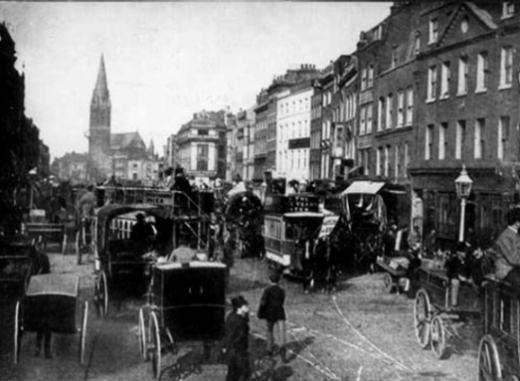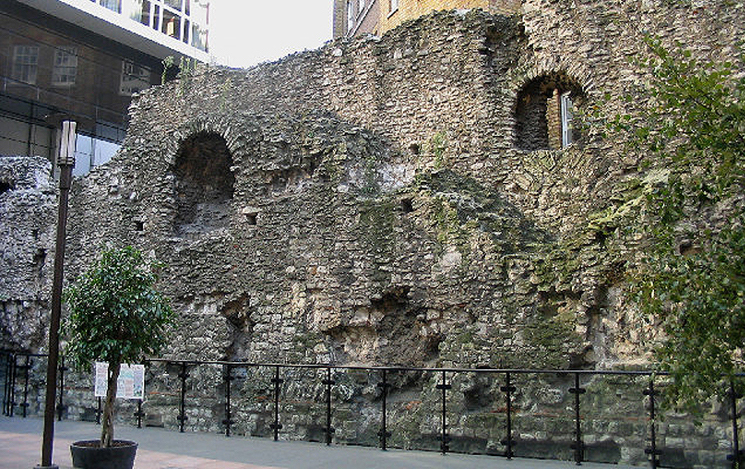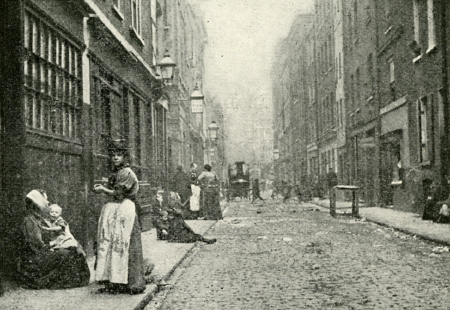Historical Overview
London: Real and Imagined
“How many thousands of us have lived for years—for a third part of our lives, probably, in London—and have never been down the Whitechapel Road? I declare that there are not half a dozen persons in the circle of my acquaintance who can tell me where Bethnal Green is. As to Ratcliffe Highway, Shadwell, Poplar, Limehouse, and Rotherhithe, they are entirely terrae incognitae to shoals of born-and-bred Londoners.

London, East End, Whitechapel High Street, 1905
‘Down Whitechapel way.’ Have you ever been ‘down’ that way, reader? Ten to one you have not. You have heard, probably, of Whitechapel needles; and the costermonger from whom you may occasionally have condescended to purchase vegetables would very likely inform you, were you to ask him, that he lives ‘down that way.’ Perhaps your impressions connected with Whitechapel refer vaguely to butchers, or, probably, to Jews, or possibly to thieves. Very likely you don’t trouble yourself at all about the matter. You had an aunt once who lived at Mile End: but she quarrelled with everybody during her lifetime, and left her money to the London Hospital when she died, and you never went to see her. You see scores of omnibuses pass your door daily, with Aldgate, Whitechapel, Mile End, painted on their panels; but you have no business to transact there, and let the omnibuses go on their way without further comment”. 1
Late-Victorian London is one of the most oft-studied places in history. It has not only been a site of fascination for generations of historians, but Londoners themselves were particularly intrigued by their own world, and there were countless social investigators, health reformers, journalists and artists who wandered through the city investigating its workings.2 Paris may have been the city of the flâneur, but London was the city of the urban investigator. And what social investigators loved doing above all else, perhaps, was discovering something new. London was so much bigger than it had ever been, and was so much larger than any other city in the late nineteenth century, that its scale made the project of narrating or charting the city seemingly endless. E.V. Lucas preferred to wander the city that seemingly had no beginning nor end; he wrote that a thousand books could be written about the place and still not be exhaustive.3 There were tourist guides, government reports, works of fiction, illustrated maps, and all manner of representations of the city. There was a real demand for literature that went deeper, and exposed truths of the city lying beneath the surface.4
East vs. West
American novelist Henry James eventually came to love London. And yet when he first travelled there, he was horrified by the place.
“London was hideous, vicious, cruel, and above all overwhelming... [I] would rather even starve, than sally forth into the infernal town, where the natural fate of an obscure stranger would be to be trampled to death in Piccadilly and have his carcass thrown into the Thames.”5
It is likely that many urban investigators exaggerated the more frightening or unknown parts of London in an attempt to make their own explorations all the more heightened.6 However, London was a city unlike any other at the time. And of the many ways people tried to comprehend such a sprawling and imposing city, one of the most lasting was the idea that the city was bisected along its core into a wealthy West End and a poor East End

London Wall Fragment, 2005
This was a metaphor that echoed a larger social and economic problem. In his 1845 novel Sybil; or, the Two Nations, Benjamin Disraeli (later Conservative Prime Minister) believed the rich and poor were becoming so isolated it was as if they were living in two different countries. By the 1880s this fear had only magnified. “The separation of classes in modern society is serious enough—that the ‘two nations’ should still live side by side with so little sympathy, so little help ended by the one to the other” was unsustainable, according to one reformer.7
The idea of a poor East End marked by the old Roman walls was a potent symbol of the class divide, even if the reality was slightly more complex. The East End was the site of the London Docks, gateway to the world and home to thousands of dockers and itinerant labourers. The East End was also home to waves of immigrants and refugees: from the Hugenots of the seventeenth century to the Irish of the eighteenth to mid nineteenth century to the Eastern European Jews of the late nineteenth century. 8
Life in the Slums
The website covers a period of time that was rife with attempts to “clean up” the East End. The most obvious way to do so was to tackle the dilapidated slum dwellings in the area. The Artizans’ and Labourers’ Dwelling Act of 1876 gave the government the power to seize dilapidated properties from landlords and opened access to public monies to build new housing. However, this was just one in a series of acts intended to deal with the problem of slums that failed to live up to expectations. By 1885 there had been three decades of abortive housing legislation that only seemed to have made the situation worse. The desire to tear down dilapidated buildings was a good one; however, the housing built to replace it failed to match the numbers destroyed. 9

Whitechapel, Dorset Street, 1902
Some reformers chose to build rather than destroy. Arnold Toynbee started a lecture series in the East End in the 1870s that quickly ballooned into his founding a residential institution, library, and art gallery. He explained he did so as in the past the middle classes had failed the poor. At one lecture he explained that “instead of justice we have offered you charity, and instead of sympathy, we have offered you hard and unreal advice; but I think we are changing…I think that many of us would spend our lives in your service.” 10 Toynbee was one of a number of people involved in the settlement house movement, where the middle classes practiced their philanthropy in the heart of the East End.
Finding Whitechapel
What is Whitechapel? While the districts of Whitechapel could be drawn on the map (and have been redrawn over time), the boundaries in people's imaginations varied widely. Newspaper reports often listed a street as being in Whitechapel, even though technically it was beyond the bounds of the district. The boundaries of Whitechapel often blurred with other areas of Tower Hamlets in people’s imagination. We decided to include some points not technically within Whitechapel on the map when authors identified those addresses as being in Whitechapel. In public conversations, it mattered more where people believed Whitechapel was, rather than the strict boundaries of the district. In trying to tease out perceptions of an area, it is opinion that matters most.
However, the boundaries between areas sometimes did make a practical difference at times. No more so than in the death of Catherine Eddowes who was found dead in Mitre Square. She was quickly reported as yet another victim of the Whitechapel murderer. Yet Mitre Square was not in Whitechapel; it was in the City of London. In this case the specific location made a tangible difference. The historic City of London, the "one square mile", had a separate police force from the rest of London: the City of London Police. Based at 26 Old Jewry, the City of London Police was independent from the Metropolitan Police. The fact that two police forces were involved added jurisdictional disputes on top of an already complicated case. So much so that Charles Warren actually wrote to James Fraser in an attempt to coordinate their researches. As he notes to Fraser, “We are inundated with suggestions and names of suspects.”11
- 1 George Augustus Sala, Gaslight and Daylight (London: Chapman and Hall, 1859), 257.
- 2 Amy Milne-Smith, “Men on the Town: Writing Late-Victorian London,” The Victorian Web: Literature, History & Culture in the Age of Victoria.
- 3 E.V. Lucas, A Wanderer in London, 10th edn (London: Methuen & Co. Ltd, 1911), 1.
- 4 David Gilbert and Fiona Henderson, "London and the Tourist Imagination," in Imagined Londons, ed. by Pamela K. Gilbert (Albany: State University of New York Press, 2002), 121-136 (p. 283).
- 5 Henry James, “London,” in London Stories and Other Writings (Padstow: Tabb House, 1989), 245.
- 6 Emma Francis and Nadia Valman, “Introduction: Revisiting the Victorian East End,” 19: Interdisciplinary Studies in the Long Nineteenth Century, 13 (2011), 1.
- 7 Philip Lyttleton Gill, Universities Settlement in East London: The Municipal Responsibilities of the ‘Well-to-do,” n.d.
- 8 Jerry White, London in the Nineteenth Century: ‘A Human Awful Wonder of God,’ London: Vintage Books (2011), 109, 136, 130
- 9 Sarah Wise, The Blackest Streets: The Life and Death of a Victorian Slum, London: Vintage (2008), 23-24.
- 10 Quoted in Roy Porter, London: A Social History, London: Penguin (1994), 370.
- 11 Letter from Charles Warren to Sir James Fraser, 9 October 1888 MEPO 1/48, The National Archives, London.